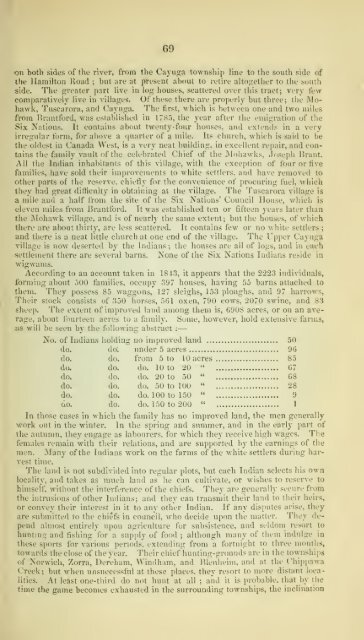Smith's Canadian gazetteer - ElectricCanadian.com
Smith's Canadian gazetteer - ElectricCanadian.com
Smith's Canadian gazetteer - ElectricCanadian.com
Create successful ePaper yourself
Turn your PDF publications into a flip-book with our unique Google optimized e-Paper software.
—<br />
69<br />
I lie site of the Six Nations' Council House, which is<br />
on both sides of the river, from the Cayuga township line to the south side of<br />
the Hamilton Iload ; but are at present about to retire altojiether to the south<br />
side. The fjreater part live in log houses, scattered over this tract; very few<br />
<strong>com</strong>paratively live in villages. Of these there are projjerly but three; the Mohawk,<br />
Tuscarora, and Cayuga, The first, which is betM-een one and two miles<br />
from Brantford, was established in 17S5, the year after the emigration of the<br />
Six Nations. It contains about tM'enty-four houses, atul extends in a very<br />
irregular form, for above a (juarler of a mile. Its cburcli, which is said to be<br />
the oldest in Canada Wt'st, is a very neat building, in excellent re])air, and contains<br />
the family vault of the celebrated Chief of the Mohawks, Joseph Brant<br />
All the Indian inhabitants of this village, with the exception of four or five<br />
families, have sold their improvetnents to white settlers, and have removed to<br />
other parts of the reserve, chiefly for the convenience of procuring fuel, which<br />
they had great difficulty in obtaining at the village. The Tuscarora village is<br />
a mile and a half from<br />
eleven miles from lirantibrd. It was established ten or fifteen years later than<br />
the Mohawk village, and is of nearly the same extent; but the houses, of which<br />
there are about thirty, are less scattered. It contains few or no white settlers<br />
and there is a neat little church at one end of the village.<br />
;<br />
The Upper Cayuga<br />
village is now deserted by the Indians; the houses are all of logs, and in each<br />
settlement there are several barns. None of the Six Nations Indians reside in<br />
wigwams.<br />
According to an account taken in 1843, it appears that the 2223 individuals,<br />
forming a1)out 500 families, occupy 397 houses, having 55 barns attached to<br />
them. They possess 85 waggons, 127 sleighs, 153 ploughs, and 97 harrows,<br />
Their stock consists of 350 horses, 561 oxen, 790 cows, 2070 swine, and 83<br />
aheep. The extent of improved laud among them is, 6908 acres, or on an average,<br />
about fourteen acres to a family. Some, however, hold extensive farms,<br />
as will be seen by the following abstract ;<br />
No. of Indians holding no improved land 50<br />
do. do'. under 5 acres 96<br />
do. do. from 5 to lOacres 85<br />
do. do. do. 10 to 20 " 67<br />
do. do. do. 20 to 50 " 68<br />
do. do. do. 50 to 100 " 28<br />
do. do. do. 100 to 150 " 9<br />
da do. do. 150 to 200 " 1<br />
In those cases in which the family ha.s no improved land, the men generally<br />
work out in the winter. In the spring and summer, and in the early part of<br />
the autunm, they engage as labourers, for which the)' receive high wages. The<br />
females remain with their relations, and are supported by the earnings of the<br />
men. Many of the Indians work on the farms of the white settlers during harvest<br />
time.<br />
The land is not subdivided into regular plots, but each Indian selects his own<br />
locality, and takes as much land as he can cultivate, or wishes to reserve to<br />
himself, without the interference of the chiefs. They are generally secure from<br />
the intrusions of other Indians; and they can transmit their land to their heirs,<br />
or convey their interest in it to any other Indian. If any disputes arise, they<br />
are submitted to the chiefs in council, who decide upon the matter. They depend<br />
almost entirely upon agriculture for subsistence, and seldom resort to<br />
huntmg and fishing tor a supply of food ; although many of them indulge in<br />
these sports for various periods, extending from a fortnight to three months,<br />
towards the close of the year. Their chief hunting-grounds are in the townships<br />
of Norwich, Zorra, Dereham, Windham, and Hlenheim, and at the Chipi)awa<br />
Creek; but when unsuoces^^ful at these places, they resort to more distant localities.<br />
At least one-third do not hunt at all ; and it is probable, that by the<br />
time the game be<strong>com</strong>es exhausted in the surrounding townships, the inclination

















